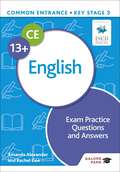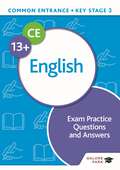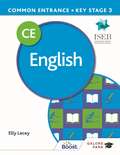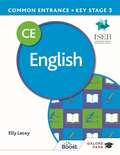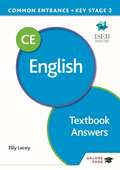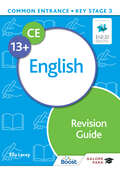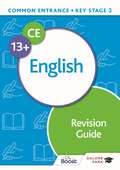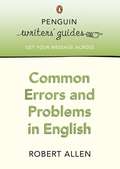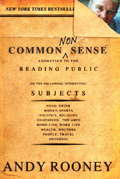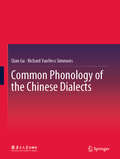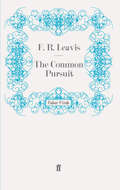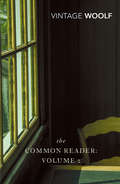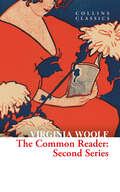- Table View
- List View
Common Core Grammar Toolkit, The: Using Mentor Texts to Teach the Language Standards in Grades 3-5
by Sean RudayThe Common Core’s language standards can seem overwhelming—students need to learn specific, complex grammar rules at each grade level. The Common Core Grammar Toolkit to the rescue! This comprehensive guide makes grammar instruction fun and meaningful. You will learn how to… Teach the Common Core’s language standards for grades 3–5 by presenting each grammar rule as a useful writing tool. Use mentor texts—excerpts from great literature—to help students understand grammar in action. Promote metacognition along the way, so that students become responsible for their own learning. Throughout the book, you'll find step-by-step recommendations for teaching each of the grammar tools, plus classroom snapshots that show you the tools in action, and handy templates that you can use in the classroom. Bonus! The book includes a free annotated bibliography, which is offered as a Supplemental Download on our website. The bibliography lists high-quality young adult literature and gives examples of key grammatical concepts found in each work. It also provides the Common Core Language Standard associated with those concepts!
Common Core Grammar Toolkit, The: Using Mentor Texts to Teach the Language Standards in Grades 3-5
by Sean RudayThe Common Core’s language standards can seem overwhelming—students need to learn specific, complex grammar rules at each grade level. The Common Core Grammar Toolkit to the rescue! This comprehensive guide makes grammar instruction fun and meaningful. You will learn how to… Teach the Common Core’s language standards for grades 3–5 by presenting each grammar rule as a useful writing tool. Use mentor texts—excerpts from great literature—to help students understand grammar in action. Promote metacognition along the way, so that students become responsible for their own learning. Throughout the book, you'll find step-by-step recommendations for teaching each of the grammar tools, plus classroom snapshots that show you the tools in action, and handy templates that you can use in the classroom. Bonus! The book includes a free annotated bibliography, which is offered as a Supplemental Download on our website. The bibliography lists high-quality young adult literature and gives examples of key grammatical concepts found in each work. It also provides the Common Core Language Standard associated with those concepts!
Common: The Development of Literary Culture in Sixteenth-Century England
by Neil RhodesThis volume explores the development of literary culture in sixteenth-century England as a whole and seeks to explain the relationship between the Reformation and the literary renaissance of the Elizabethan period. Its central theme is the 'common' in its double sense of something shared and something base, and it argues that making common the work of God is at the heart of the English Reformation just as making common the literature of antiquity and of early modern Europe is at the heart of the English Renaissance. Its central question is 'why was the Renaissance in England so late?' That question is addressed in terms of the relationship between Humanism and Protestantism and the tensions between democracy and the imagination which persist throughout the century. Part One establishes a social dimension for literary culture in the period by exploring the associations of 'commonwealth' and related terms. It addresses the role of Greek in the period before and during the Reformation in disturbing the old binary of elite Latin and common English. It also argues that the Reformation principle of making common is coupled with a hostility towards fiction, which has the effect of closing down the humanist renaissance of the earlier decades. Part Two presents translation as the link between Reformation and Renaissance, and the final part discusses the Elizabethan literary renaissance and deals in turn with poetry, short prose fiction, and the drama written for the common stage.
Common: The Development of Literary Culture in Sixteenth-Century England
by Neil RhodesThis volume explores the development of literary culture in sixteenth-century England as a whole and seeks to explain the relationship between the Reformation and the literary renaissance of the Elizabethan period. Its central theme is the 'common' in its double sense of something shared and something base, and it argues that making common the work of God is at the heart of the English Reformation just as making common the literature of antiquity and of early modern Europe is at the heart of the English Renaissance. Its central question is 'why was the Renaissance in England so late?' That question is addressed in terms of the relationship between Humanism and Protestantism and the tensions between democracy and the imagination which persist throughout the century. Part One establishes a social dimension for literary culture in the period by exploring the associations of 'commonwealth' and related terms. It addresses the role of Greek in the period before and during the Reformation in disturbing the old binary of elite Latin and common English. It also argues that the Reformation principle of making common is coupled with a hostility towards fiction, which has the effect of closing down the humanist renaissance of the earlier decades. Part Two presents translation as the link between Reformation and Renaissance, and the final part discusses the Elizabethan literary renaissance and deals in turn with poetry, short prose fiction, and the drama written for the common stage.
Common Discourse Particles in English Conversation (RLE: Discourse Analysis)
by Lawrence C. SchourupFirst published in 1985, this book studies several common items in English conversation known variously as ‘discourse particles’, ‘interjections’, ‘discourse markers’, and, more informally, ‘hesitations’ or ‘fillers’. While the analysis primarily focuses on ‘like’, ‘well’ and ‘you know’, the larger concern is the entire set of items of which these are members and as such ‘I mean’, ‘now’, ‘oh’, ‘hey’, and ‘aha’ are also examined. These discourse particles are analysed at length and then a framework is proposed in which their use individually makes sense and allows revealing comparisons to be made between them. This book will be of interest to students of linguistics
Common Discourse Particles in English Conversation (RLE: Discourse Analysis)
by Lawrence C. SchourupFirst published in 1985, this book studies several common items in English conversation known variously as ‘discourse particles’, ‘interjections’, ‘discourse markers’, and, more informally, ‘hesitations’ or ‘fillers’. While the analysis primarily focuses on ‘like’, ‘well’ and ‘you know’, the larger concern is the entire set of items of which these are members and as such ‘I mean’, ‘now’, ‘oh’, ‘hey’, and ‘aha’ are also examined. These discourse particles are analysed at length and then a framework is proposed in which their use individually makes sense and allows revealing comparisons to be made between them. This book will be of interest to students of linguistics
Common Entrance 13+ English Exam Practice Questions and Answers
by Amanda Alexander Rachel GeeExam board: ISEB Level: 13+ CE and KS3 Subject: English First exams: November 2022Improve exam technique and build confidence to ensure success in the CE 13+ English exams with these practice papers in the style of the ISEB exams.· Prepare for all papers: questions cover all areas of the ISEB specification for all levels, with exam advice.· Guidance on the exam: practice in answering multiple choice questions, extended response questions, and planning and writing the written tasks.· Identify gaps in skills: answers with guidance included to help pinpoint areas for improvement.Pair with Common Entrance 13+ English Revision Guide for comprehensive exam preparation (ISBN: 9781398340909).
Common Entrance 13+ English Exam Practice Questions and Answers
by Amanda Alexander Rachel GeeExam board: ISEB Level: 13+ CE and KS3 Subject: English First exams: November 2022Improve exam technique and build confidence to ensure success in the CE 13+ English exams with these practice papers in the style of the ISEB exams.· Prepare for all papers: questions cover all areas of the ISEB specification for all levels, with exam advice.· Guidance on the exam: practice in answering multiple choice questions, extended response questions, and planning and writing the written tasks.· Identify gaps in skills: answers with guidance included to help pinpoint areas for improvement.Pair with Common Entrance 13+ English Revision Guide for comprehensive exam preparation (ISBN: 9781398340909).
Common Entrance 13+ English for ISEB CE and KS3
by Elly LaceyExam board: ISEB Level: 13+ CE and KS3 Subject: English First teaching: September 2021 First exams: November 2022Support your pupils in developing enhanced comprehension and writing skills across a wide range of challenging, diverse and engaging themes and genres with Common Entrance English 13+ for ISEB CE and KS3. This new resource will help your pupils achieve their full potential in the ISEB 13+ CE exams and other Independent School exams at 13+.· Expand your pupils' reading preferences: 10 thematically-arranged chapters with topics including Growing Up, Our Planet, Loud and Proud, and Different People, Different Perspectives.· Encourage independent research and learning: Research panels throughout pose questions that encourage pupils to deepen their understanding of a topic or issue independently. Plus, Wider Reading boxes offer suggestions for additional independent reading.· Develop your pupils' appreciation of drama: Greater emphasis on drama skills including role play, character development, thought tracking, directing a short extract, using stage directions, and drafting a short script extract.· Prepare for Paper 2 with end-of-chapter writing tasks: Help your pupils to structure and develop their writing in a variety of genres with directed writing tasks at the end of every chapter.· Improve exam results: New Exam Skills chapter covers Reading Skills, Writing Skills, Planning and Writing your Responses, and Spelling, Punctuation and Grammar - with sample answers and tips for improving.Accompanying answers available as a paid-for PDF download at galorepark.co.uk (ISBN: 9781398321687).
Common Entrance 13+ English for ISEB CE and KS3
by Elly LaceyExam board: ISEB Level: 13+ CE and KS3 Subject: English First teaching: September 2021 First exams: November 2022Support your pupils in developing enhanced comprehension and writing skills across a wide range of challenging, diverse and engaging themes and genres with Common Entrance English 13+ for ISEB CE and KS3. This new resource will help your pupils achieve their full potential in the ISEB 13+ CE exams and other Independent School exams at 13+.· Expand your pupils' reading preferences: 10 thematically-arranged chapters with topics including Growing Up, Our Planet, Loud and Proud, and Different People, Different Perspectives.· Encourage independent research and learning: Research panels throughout pose questions that encourage pupils to deepen their understanding of a topic or issue independently. Plus, Wider Reading boxes offer suggestions for additional independent reading.· Develop your pupils' appreciation of drama: Greater emphasis on drama skills including role play, character development, thought tracking, directing a short extract, using stage directions, and drafting a short script extract.· Prepare for Paper 2 with end-of-chapter writing tasks: Help your pupils to structure and develop their writing in a variety of genres with directed writing tasks at the end of every chapter.· Improve exam results: New Exam Skills chapter covers Reading Skills, Writing Skills, Planning and Writing your Responses, and Spelling, Punctuation and Grammar - with sample answers and tips for improving.Accompanying answers available as a paid-for PDF download at galorepark.co.uk (ISBN: 9781398321687).
Common Entrance 13+ English for ISEB CE and KS3 Textbook Answers
by Elly LaceyThis PDF download contains full answers to all exercises and activities in Common Entrance 13+ English for ISEB CE and KS3 (ISBN: 9781398321571). · Answers with marks for Reading questions. · Sample answers and mark scheme for Writing questions. · Clear layout saves time marking work, enabling efficient assessment of pupils' strengths and weaknesses. · Advice and guidance to develop pupils' skills. · A sample Scheme of Work presents the CE content which must be covered in preparation for CE 13+. It is possible to deliver the content in a number of different ways and we present an option that can be followed or adapted. As a downloadable PDF, please note this resource is non-refundable.
Common Entrance 13+ English Revision Guide
by Elly LaceyExam board: ISEB Level: 13+ CE and KS3 Subject: English First exams: November 2022This comprehensive, ISEB-endorsed English guide focuses on revising the specific reading and writing skills needed to meet the requirements of the ISEB CE 13+ exam.· A supportive step-by-step approach to practising key skills for the Reading Paper: narrative viewpoint, poetic techniques or dramatic methods.· Study a diverse range of annotated extracts: modelling ways of analysing extracts in preparation for the Reading Paper.· Hone technique for the Writing Paper: guided support for planning and reviewing written work and sample answers with marking guidance for both directed writing and creative writing tasks.· Prepare for the exam: practice tasks to consolidate revision at the end of each chapter and strategies for performing well in the exam with tips for revising effectively throughout.Continue your revision with Common Entrance 13+ English Exam Practice Questions and Answers (ISBN: 9781398326484).
Common Entrance 13+ English Revision Guide
by Elly LaceyExam board: ISEB Level: 13+ CE and KS3 Subject: English First exams: November 2022This comprehensive, ISEB-endorsed English guide focuses on revising the specific reading and writing skills needed to meet the requirements of the ISEB CE 13+ exam.· A supportive step-by-step approach to practising key skills for the Reading Paper: narrative viewpoint, poetic techniques or dramatic methods.· Study a diverse range of annotated extracts: modelling ways of analysing extracts in preparation for the Reading Paper.· Hone technique for the Writing Paper: guided support for planning and reviewing written work and sample answers with marking guidance for both directed writing and creative writing tasks.· Prepare for the exam: practice tasks to consolidate revision at the end of each chapter and strategies for performing well in the exam with tips for revising effectively throughout.Continue your revision with Common Entrance 13+ English Exam Practice Questions and Answers (ISBN: 9781398326484).
Common Errors and Problems in English
by Robert AllenThe Penguin Writers' Guides series provide authoritative, succinct and easy-to-follow guidance on specific aspects of written English. Whether you need to brush up your skills or get to gris with something for the first time, these invaluable Guides will help you find the best way to get your message across clearly and effectively.Common Errors in English is a thorough A-Z checklist of the mistakes that often crop up in all aspects of written English. It gives ready and authoritative guidance on today's usage difficulties, being up-to-date with all the latest controversies, pitfalls and oddities of our language. Written in a lively style, with plenty of interest and humour, Common Errors shouldn't be far from the fingertips of anyone who does any kind of writing.
Common Ground on Hostile Turf: Stories from an Environmental Mediator
by Lucy MooreIn our increasingly polarized society, there are constant calls for compromise, for coming together. For many, these are empty talking points—for Lucy Moore, they are a life's work. As an environmental mediator, she has spent the past quarter century resolving conflicts that appeared utterly intractable. Here, she shares the ten most compelling stories of her career, offering insight and inspiration to anyone caught in a seemly hopeless dispute.Moore has worked on wide-ranging issues—from radioactive waste storage to loss of traditional grazing lands—and with diverse groups, including ranchers, environmentalists, government agencies, and tribal groups. After decades spent at the negotiating table, she has learned that a case does not turn on facts, legal merit, or moral superiority. It turns on people.This book should be especially appealing to anyone concerned with environmental conflicts; and also to students in environmental studies, political science, and conflict resolution, and to academics and professionals in mediation and conflict resolution fields.
Common Measures: Romanticism and the Groundlessness of Community
by Joseph AlbernazWhat happens to the experience of community when the grounds of communal life collapse? The Romantic period's upheaval cast both traditional communal organizations of life and outgrowths of the new revolutionary age into crisis. In this context, Joseph Albernaz argues that Romantic writers articulate a vital conception of "groundless community," while following this idea through its aesthetic, ecological, political, and philosophical registers into the present. Amidst the violent expropriation of the commons, Romantic writers including the Wordsworths, Clare, Hölderlin, and the revolutionary abolitionist Robert Wedderburn reimagined the forms of their own lives through literature to conceive community as groundless, a disposition toward radically open forms of sharing—including with nonhuman beings—without recourse to any collective identity. Both a poetics and ethics, groundless community names an everyday sociality that surges beneath and against the enclosures of property and identity, binding us to the movements of the earth. Unearthing Romanticism's intersections with the history of communism and the general strike, Albernaz also demonstrates how Romantic literature's communal imagination reverberates through later theories of community in Bataille, Derrida, Nancy, Moten, and others. With sharp close readings, new historical constellations, and innovative theoretical paradigms, Common Measures recasts the relationship of the Romantic period to the basic terms of modernity.
Common Nonsense
by Andy Rooney"Andy Rooney's Sunday evening observations on 60 Minutes are an American institution, shaping the way people see everything from coffee percolators to the state of the nation. Rooney's books, most rece"
Common Phonology of the Chinese Dialects
by Qian Gu Richard VanNess SimmonsThis book presents a comparative reconstruction of the common phonology of the Chinese dialects using representative data from living dialects. The resulting phonology includes all categories and phonological distinctions that are represented in the dialect data. It departs from the tradition of using philological sources and non-Chinese borrowings as the basis for a reconstructed system. Based on a strict comparative methodology, the phonology presented encapsulates the shared phonology of the dialects and reflects the real-world distinctions and categories found in the living dialects. For example, the initials preserve the tripartite division that includes voiced obstruents seen in Wú dialects; the finals are comparatively drawn based on the collective dialect data; and the syllable codas preserve the three-way contrasts of consonant stop endings seen in the Cantonese dialects. The data presented allows readers to observe the basis for all of the distinction and categories included in the common phonology and the relationship of that phonology to all of the dialects, and as a result to identify the dialects’ disparate developments and evolution. The English translation also includes innovative elements that render it even more useful for researchers than the Chinese original. The book is primarily intended for scholars and researchers investigating the Chinese dialects and their relationships, and the history of Chinese. It is also useful for scholars of Chinese history and literature who need a handy resource providing essential information on the historical phonology of Chinese.
Common Prayer: The Language Of Public Devotion In Early Modern England
by Ramie TargoffCommon Prayer explores the relationship between prayer and poetry in the century following the Protestant Reformation. Ramie Targoff challenges the conventional and largely misleading distinctions between the ritualized world of Catholicism and the more individualistic focus of Protestantism. Early modern England, she demonstrates, was characterized less by the triumph of religious interiority than by efforts to shape public forms of devotion. This provocatively revisionist argument will have major implications for early modern studies. Through readings of William Shakespeare's Hamlet, Richard Hooker's Lawes of Ecclesiastical Politie, Philip Sidney's Apology for Poetry and his translations of the Psalms, John Donne's sermons and poems, and George Herbert's The Temple, Targoff uncovers the period's pervasive and often surprising interest in cultivating public and formalized models of worship. At the heart of this study lies an original and daring approach to understanding the origins of devotional poetry; Targoff shows how the projects of composing eloquent verse and improving liturgical worship come to be deeply intertwined. New literary practices, then, became a powerful means of forging common prayer, or controlling private and otherwise unmanageable expressions of faith.
The Common Pursuit
by F. R. LeavisF. R. Leavis was the chief editor of Scrutiny, which between 1932 and 1953 had some claim on being the most influential literary journal in the English-speaking world. The Common Pursuit is a selection of Leavis's essays from Scrutiny, including his robust defence of Milton against T. S. Eliot, his deeply-felt engagement with Shakespeare, and his severe strictures on attempts to import sociology and political activism into the study of literature. The title of the book comes from a passage in Eliot's 'The Function of Criticism', in which the poet argues that the critic must engage in 'the common pursuit of true judgment'. For Leavis, this meant a strenuous insistence on discriminatory criticism - clear statements about what is good and morally mature and admirable, and equally clear condemnation of what is trivial. The Common Pursuit, with its controversial judgments of Bunyan and Auden, Swift and Forster, remains as challenging now as it did in 1952, and it is easy to see why Leavis - who was never offered a professorship by Cambridge University - held such sway over the study of English literature in his time.
The Common Reader: Volume 2
by Virginia Woolf'He reads for his own pleasure rather than to impart knowledge to correct the opinions of others. Above all, he is guided by an instinct to create for himself, out of whatever odds and ends he can come by, some kind of whole - a portrait of a man, a sketch of an age, a theory of the art of writing.' So Virginia Woolf described the 'common reader' for whom she wrote. This is her second series of essays, first published in 1932. Here she turns her brilliant eye on Lord Chesterfield's letters, the novels of George Gissing, the poetry of Donne: we meet Dr Burney and Beau Brummell, Christina Rossetti, Geraldine Jewsbury, Jane Carlyle, Mary Wollstonecraft and many others.
The Common Reader: First Series, Annotated Edition (Virago Modern Classics)
by Virginia WoolfThis is Virginia Woolf's first collection of essays, published in 1925. In them, she attempts to see literature from the point of view of the 'common reader' - someone whom she, with Dr Johnson, distinguished from the critic and the scholar. She read, and wrote, as an outsider: a woman set to school in her father's library, denied the educational privileges of her male siblings - and with no fixed view of what constitutes 'English Literature'. What she produced is an eccentric and unofficial literary and social history from the fourteenth to the twentieth century, with an excursion to ancient Greece thrown in. She investigates medieval England, tsarist Russia, Elizabethan playwrights, Victorian novelists and modern essayists. When she published this book Woolf's fame as a novelist was already established: now she was hailed as a brilliant interpretative critic. Here, she addresses her 'common reader' in the remarkable prose and with all the imagination and gaiety that are the stamp of her genius.
The Common Reader: First Series (Collins Classics)
by Virginia WoolfHarperCollins is proud to present its incredible range of best-loved, essential classics.
The Common Reader: Second Series (Collins Classics)
by Virginia WoolfHarperCollins is proud to present its incredible range of best-loved, essential classics.
Common Scents: Comparative Encounters in High-Victorian Fiction
by Janice CarlisleWho smells? Surveying nearly eighty novels written in the 1860s to answer that impolite question, Common Scents provides a new reading of Victorian values, particularly as they assess the relative merits of men and women, spirit and matter. In depictions of comparative encounters, the commonplace meetings of everyday life, such fiction often registers the inequalities that distinguish one individual from another by marking one of them with a smell. In a surprisingly consistent fashion, these references constitute what cultural anthropologists call an osmology, a system of differentiations that reveals the status within a particular culture of the persons and things associated with specific odors. Featuring often innocuous and even potentially pleasing aromas emanating from food, flowers, and certain kinds of labor, novels of the 1860s array their characters into distinct categories, finding in some rather than others olfactory proof of their materiality. Central to this osmology is the difference between characters who give off odors and those who do not, and this study draws upon the work of Victorian psychophysiologists and popular commentators on the senses to establish the subtlety with which fictional representations make that distinction. By exploring the far-reaching implications of this osmology in specific novels by Dickens, Eliot, Meredith, Oliphant, Trollope, and Yonge, Common Scents argues that the strikingly similar plots and characterizations typical of the 1860s, responding as they do to the economic and political concerns of the decade, reconfigure conventional understandings of the relations between men and women. Determining who smells reveals what Victorian culture at its epitome takes for granted as a deeply embedded common sense, the recognition of whose self-evident truth seems to be as instinctive and automatic as a response to an odor.



